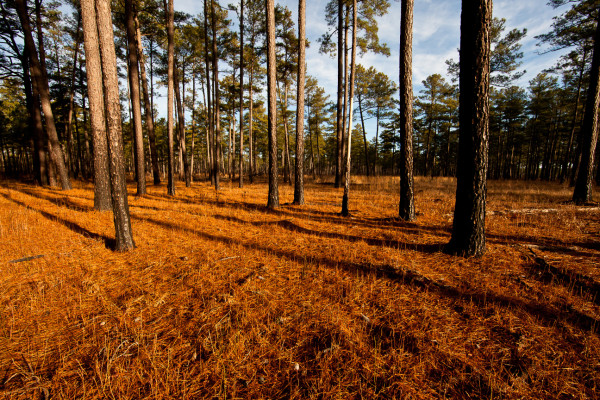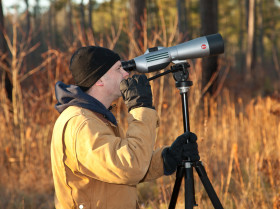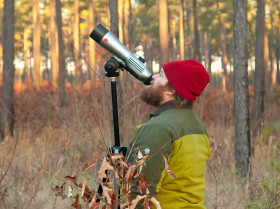Winter woodpecker census reaches modern high
Camellia – Elbow & Centerville Jan 6
January 7, 2014Hudsonian godwits go long
January 7, 2014
Center for Conservation Biology biologists finished 2013 with more good news for the Piney Grove Red-cockaded Woodpeckers as the annual winter survey of the population yielded another record high of 58 birds. The survey sets a new high watermark in the recovery of the species in Virginia. The population reached a record low in the Commonwealth in the year 2000 when only 2 breeding groups remained following decades of decline from habitat loss. It was at that time that The Nature Conservancy purchased the tract of land known as the Piney Grove Preserve with the primary objective of restoring the federally endangered woodpecker in Virginia to pre-decline levels. Over the past several years we have witnessed a sudden increase in the number of breeding groups and individuals within the preserve.

Piney Grove Preserve in winter. Red-cockaded woodpeckers are specialists on old-growth pines with fire-maintained understories. Photo by Bryan Watts.
The 58 birds detected this winter were composed of 43 adult birds and 15 young-of-the-year distributed into 12 groups. Red-cockaded Woodpeckers are cooperative breeders so the term group describes a potentially breeding adult male and female that are joined by additional helper birds. The group remains together throughout the year and throughout daily activities such as foraging. The population still retains 15 of 21 birds fledged this past summer. This retention rate is about average compared to previous years.

Mike Wilson uses a spotting scope to identify individually banded red-cockaded woodpeckers within the Piney Grove Preserve. Photo by Bryan Watts.
The most surprising finding this winter was the formation of two new groups. In general, group formation is less stable in winter than in summer so it is possible the 2 new groups could dissolve before the breeding season begins. However, one of the groups represents the first ever pioneering event at Piney Grove. Since 2000, the growth of the Red-cockaded Woodpecker population has been facilitated by the installation of artificial nesting trees and translocation of birds from South Carolina to Virginia. Over time, the Virginia birds began to move into unoccupied clusters of artificial cavities and then eventually augment those sites with their own naturally excavated cavities. However, the newly pioneered site is the result of a Virginia bird excavating its own roosting cavity without artificial facilitation and in an entirely new location on the preserve that is away from other woodpecker groups. Another new group has formed within a set of artificial cavity trees that has undergone a short-term colonization by birds a few years ago then vanished as a group site.

Fletcher Smith searches for foraging woodpeckers in the crowns of loblolly pines. Birds often forage rapidly through the crowns challenging observers to sort out birds and read their color bands. Photo by Bryan Watts.
We will continue annual monitoring of the Virginia Red-cockaded Woodpecker population with another census in spring followed by breeding season observations to document productivity. The winter survey is made possible with funding from the Virginia Department of Game and Inland Fisheries and other year-round monitoring from funds provided by The Nature Conservancy and The Center for Conservation Biology.
Written by Mike Wilson | mdwils@wm.edu | (757) 221-1649
January 7, 2014



